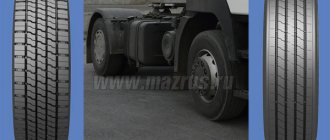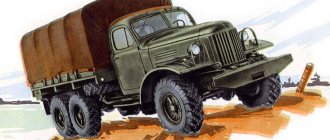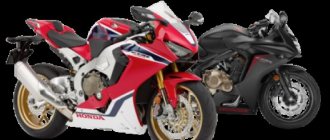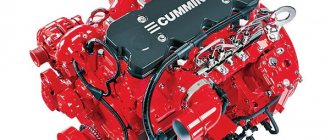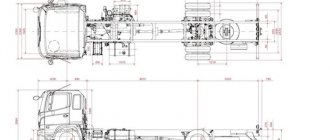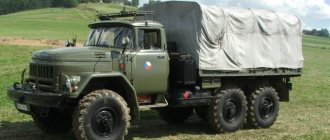Engine structure D-245: Lubrication system
When choosing an engine for a commercial vehicle, and especially a truck, of course, you should pay attention not only to efficiency, but also to engine power. Cylinder block material cast iron Engine type diesel Configuration in-line Number of cylinders 4 Valves per cylinder 2 Piston stroke, mm 125 Cylinder diameter, mm 110 Compression ratio 15.
| Type: | 4-stroke, turbocharged |
| Mixing method: | direct fuel injection |
| Number and arrangement of cylinders: | 4, row, vertical |
| Cylinder operating order: | 1-3-4-2 |
| Working volume, l: | 4,75 |
| Cylinder diameter and piston stroke, mm: | 110 / 125 |
| Compression ratio: | 15,1 |
| Specific fuel consumption, g/kW h (g/hp h): | 218 (160,3) |
| Power, kW (hp): | 80 (108,8) |
| Rotation speed, rpm: | 2400 |
| Maximum torque, N m (kg m): | 353 (36) |
| Rotation speed at maximum torque, rpm: | 1300…1700 |
| Weight, kg: | 473 |
| Overall dimensions, mm: | 1116 x 702 x 1081 |
Characteristics of D-245 About the history of the model
| What is the difference between the D240 and D245 engines 95.7 130 Nominal crankshaft rotation speed, rpm 2400 Idle speed, rpm maximum, no more than 2600 minimum, no more than 800 Oil filters full flow with a paper filter element Fuel supply system Injection pump with a mechanical regulator Volume of the lubrication system, l 10. after starting, before turning on the load, let the diesel engine run for 2-3 minutes, first at the minimum idle speed with a gradual increase to the maximum frequency;. |
| Fuel consumption of the mmz 245 engine When overhauling GAZ 66, ZIL 130, MAZ Zubrenok trucks, PAZ buses, agricultural and skidding tractors, the piston D 245 is one of the popular repair kits. For example, the Gorky Automobile Plant has been equipping its GAZ-3309, GAZ-33081 Sadko and GAZ-33104 Valdai cars with these economical and easy-to-maintain diesel engines for many years. |
Fuel consumption, operation • I don’t think that with the 245 engine you’ll get anything more worthwhile.
Necessary foreplay
This truck, produced since 2004, is interesting for two reasons - its increased payload capacity to 8 tons and the six-cylinder MMZ D-260.11 E2 diesel engine with a power of 178 hp. with a solid torque value of 708 Nm. The bet on imported (albeit from a neighboring country) diesel engine was not made because life was good - it’s just that AMO ZIL currently does not have its own diesel engine, despite many years of efforts to create it and put it into production.
About thirty years ago, against the backdrop of a sharp rise in oil prices on the world market, the USSR adopted a large-scale program for the total dieselization of road transport. In addition to the modernization of YaMZ engines, it meant the launch of KamAZ diesel production facilities and the development of a number of new families of diesel engines, including even small-displacement diesel engines for passenger cars. In the conditions of the command-administrative management system falling into ever greater paralysis, they managed to create diesel engines for both VAZ (small-displacement) and GAZ (air-cooled), and for UralAZ they purchased a license for the Deutz engine (also an “air vent”), and ZIL was entrusted with development of our own family of diesel engines ZIL-645. Unlike previous projects, this naturally aspirated water-cooled engine produces about 180 hp. reached serial production and was installed on serial products in 1986–2003. A huge plant was specially built in the city of Yartsevo, Smolensk region, to produce about 150,000 diesel engines per year, but it did not have time to enter large-scale production of engines. Market reforms broke out.
Cooling System Maintenance
This way you can ensure that the cylinder head planes are completely adjacent to the block. First, you should remove deposits from the water holes of the combustion chamber, BC and cylinder head, then start changing the gaskets. The cylinder head cover gasket has a grooved surface. For proper installation, the grooved surface must face the cylinder head cover. It is necessary to adjust the force for tightening the cylinder head cover fastening nuts - it should be from 0.5 to 0.6 kgf∙m (from 5 to 6 N∙m). It is necessary to tighten evenly.
↓ Useful information on conversion:
- In a question-and-answer style, we will try to answer questions that arise regarding the conversion of a ZIL car to diesel fuel.
- Instructions for converting ZIL-130/-131 vehicles with D-245.9/9E2 diesel engines
Photos from the D245.9-402X engine warehouse
Diesel engine ZIL-654
The process of developing a diesel engine was complicated by the fact that ZIL had virtually no experience in building such engines. As a result, the plant designers turned for advice to colleagues from NAMI, YaMZ, etc. In addition, Zilovites studied the design of domestic and imported engines. Thus, the working process of mixture formation in ZIL-645 occurred according to the volumetric-wall type (D-process). A similar process was implemented in the engines of the Deutz FL-413 family, which were used in Magirus trucks .
The fuel was supplied by the nozzle through two nozzle holes, almost parallel to the wall of the combustion chamber. By the end of the compression stroke, an intense rotational movement of the air charge was created in the combustion chamber, and part of the fuel was blown onto the walls of the combustion chamber, forming a film. Under such conditions, fuel combustion occurred smoothly and quite efficiently. As a result, the engine ran quite quietly, and its exhaust was less toxic. In addition, thanks to the controlled combustion process and a fairly high compression ratio (18.5), the ZIL-645 was multi-fuel. It could run on pure AI-80 gasoline, aviation kerosene, a mixture of gasoline and diesel fuel, and diesel fuel.
Cylinder head
Diesel engines D-260 and their modifications are 4-stroke, piston, six-cylinder internal combustion engines, with a single-row, vertical cylinder arrangement, equipped with a direct fuel injection system and ignition of the fuel mixture from compression. At first glance, the power ratings are insufficient for engines of this volume, but in reality this MMZ engine provides excellent traction even for heavy modifications of ZILs and various trucks.
Trucks and buses
ZIL-127
The ZIL-127 bus is a ZIS-127 car renamed in 1956. A diesel six-cylinder engine with a power of 180 hp is installed under the hood. Driven by a four-speed manual transmission.
ZIL-130
The most popular truck of Soviet times. The model was developed in the mid-1950s to replace cars marked 150 and 164. The first car rolled off the assembly line in 1962, and two years later mass production began. To move the 10.5 ton truck, significant effort was required. A V8 petrol engine with a capacity of 6 liters and 148 hp was installed. With. After a while, the power was increased to 150 hp. A five-speed synchronized gearbox was used as a control element. One of the modifications of this truck was the ZIL-131 model, equipped with a 6.0-liter eight-cylinder gasoline engine with a capacity of 150 hp. With. All cars in this line had a five-speed gearbox and power steering.
Design of the D-245 diesel engine. About the history of the model
The axial force of the crankshaft is perceived by 4 bimetallic or aluminum alloy half rings, which are installed in the bores of the BC and the cover of the 5th main bearing. They are distinguished not only by high reliability, but also by efficiency when operating in any weather conditions, which makes MMZ engines indispensable for heavy equipment: tractors, loaders, excavators and buses.
| Manufacturer | MMZ |
| Type of gas exchange system | with turbocharging and ONV |
| Power (kW/hp) | 100/136 |
| Rated speed (rpm) | 2400 |
| dimensions | 1011*702*1080 mm |
| Weight | 530 kg |
Engine D-245.9E2-257 EURO-2 / 136hp. for conversion of ZIL-130/. History of development
| ENGINE D245. 9-402Х (136 hp for conversion of ZIL-130 to diesel) (D-245. 9-402Х) Price. Options. Specifications. MMZ D245. 9 D-245-9. Minsk Motor Plant Delivery throughout Russia 114 155 Rotation speed, rpm 2100 Maximum torque, N m kg m 622 63.5 Rotation speed at maximum torque, rpm 1400 Weight, kg 700 Parameter name D-260 Starter 3002. It is important to understand that the most important component of such engines is the turbine, so if it works properly and is lubricated on time, your D-245 will work perfectly for many years. |
- air cleaner 5301-1109010 = 1 piece
- sleeve 18x29-1.3 (400) = 1 piece
- pipe 245-1109408 = 1 piece
- pipe 260-1109009-A = 1 piece
- bracket 245-1109500 = 1 piece
- fitting bolt 245-1104787= 1 piece
- clamp 245-1109309= 2pcs
- clamp XC-101.016 = 2 pcs
- clamp HS-71.016 = 2 pcs
- clamp 20-32/9-С7 W1S = 2 pieces
- wing nut M6-6N.45L.016 = 2 pcs.
- nut M6-6N.6.016(S10) = 4pcs
- washer A6.01.08KP.016 = 4pcs
- O-ring 245-1104788 = 2 pieces
Gas distribution mechanism • 3701-1 28V EFU has a TKR 7-00 turbocharger.
Conversion of ZIL trucks to diesel, 130, 131, gas, d 245
Our company has extensive experience in converting ZIL cars to diesel fuel.
Re-equipment of ZIL trucks allows you to increase the cross-country ability, efficiency and environmental friendliness of trucks. The company installs more modern diesel engines D-245.9, MMZ D-245.12S and other engines from this family for various modifications of ZIL-130 and ZIL-131 vehicles. The specifics of converting ZIL vehicles to diesel by our company are as follows.
Our specialists will deliver you and install the engine on your car within two or three days at the location of your business;
The modern D-245 engine is very economical in terms of specific fuel consumption. Thanks to modern design improvements, it has been possible to achieve half the consumption of a conventional, standard gasoline engine. For operation in extreme cold, which is typical for Russia, a special engine and fuel heating system is used.
If you order the conversion of ZIL cars to diesel from us, this also includes the cost of all the necessary documents to legalize the engine replacement.
The transmission will remain the same as it was before the engine was replaced in your car.
You receive a guarantee in our center. By registering, you are entitled to warranty repairs and scheduled maintenance. After the warranty expires, it will be beneficial for you to contact us if you need post-warranty engine repairs in Yaroslavl, since our company will store a map of your engine, which will help in the future to prevent emergency situations and replace used parts in a timely manner. Additionally, you get the opportunity to overhaul the engine.
Installation of the OM-366 engine on a ZIL
Questions can only be asked after registration. Please login or register.
Hello everyone, I want to try to stuff a Mercedes engine under the hood of a Zil, I know for sure that already half of Ukraine is driving with such engines, but no one is answering how and what!? If anyone has done this weird thing, please share, I already have the engine and I’ll go buy it one of these days if I like it.
I think it’s easier than for the Metezovsky one, just take it straight away from the gearbox and all the attachments so you don’t have to look for the edges
Today I started it, checked the engine on the ground, it started without problems, I was especially pleased with the stability, throttle response and noiselessness of the engine.
What model of Zila will you install it on?
Hello. It has four cylinders and how many horses does it have?
What model of Zila will you install it on?
In general, 45065 would be ideal for our work, no better. If I don’t find such a model, then I’ll make a collective farmer out of 43336.
Hello. It has four cylinders and how many horses does it have?
hi, this is a 6-line with a volume of 6 liters, turbocharged 170 hp.
Today I started it, checked the engine on the ground, it started without problems, I was especially pleased with the stability, throttle response and noiselessness of the engine.
Sanya Litvinenko. I was crawling on the Internet and somehow found a video with Zil, where such a BEAUTIFUL engine was installed. In this zil the installation was shown (how it stands) By the way, this zil was also sold in UKRAINE somewhere
Hello. It has four cylinders and how many horses does it have?
hi, this is a 6-line with a volume of 6 liters, turbocharged 170 hp.
Hello. Just what you need. Good luck.
Yes, I saw it too, and I looked at a couple of other Zils with square cabs with such engines on the net and called the owners, but they are somehow reluctant to tell. and this 130th simple aspirated engine costs 132 hp.
Yes, I saw it too, and I looked at a couple of other Zils with square cabs with such engines on the net and called the owners, but they are somehow reluctant to tell. and this 130th simple aspirated engine costs 132 hp.
I was crawling, looking for that Zil with your turbo engine. everything was described in detail in the video and photo (I was looking for sale), but I couldn’t find it - apparently they had already sold it and the ad had already been deleted
hi, these are the photos
Hi. Yes, this is what you need.
Sanya Litvinenko, how are you doing with your IDEA.
Hello, the process will be very long because I haven’t found the car I want to install this diesel engine in yet, but I’ve already figured out with my own eyes what the front engine mount will look like.
Today I started and checked the engine on the ground, it started without problems, I was especially pleased with the stability, throttle response and noiselessness of the engine.
Hello, Sanya Litvinenko! That's why it has a six-cylinder!
In theory, the I6 in the four-stroke version is a completely balanced configuration with respect to the inertia forces of different orders of the pistons and the upper parts of the connecting rods (the inertia forces of the 1st order of different cylinders cancel each other out in the same way as in an inline four-cylinder engine, but, unlike the latter, 2nd order inertial forces are also mutually compensated), combining relatively low complexity and manufacturing cost with good smooth operation. The same balance is demonstrated by the V12, which operates as two six-cylinder engines with a common crankshaft.
ZIL-169
ZIL-9E169 built in 1980.
The plant began development of a diesel engine on its own initiative in 1971. It was assumed that the new engine would fit under the hood of a promising truck (ZIL-4331 family), which would replace the rapidly aging ZIL-130. At the same time, from the very beginning, broad unification of the main components (clutch, gearbox, etc.) of the future new product with the current flagship of the plant was envisaged. This was dictated for reasons of economy, given the colossal production volume of the ZIL-130. Be that as it may, from its gasoline predecessors, the ZIL-645 borrowed only a V-shaped cylinder arrangement and approximately the same dimensions.
In 1974, the first experimental ZIL-645 was ready. It had a displacement of 7.6 liters and a power of 160 hp. and torque 451 Nm. The first tests showed that the traction and dynamic characteristics of the engine were not enough to operate as part of a road train with a total weight of 20.5 tons. As a result, in 1976, the ZIL-645 appeared with a displacement increased to 8.74 liters and a power of 185 hp. and a torque of 510 Nm. Initially, the construction of motors was carried out in the experimental workshop of ZIL.
ZIL-169 with semi-trailer OdAZ-9370
In parallel with this, the construction of a motor plant began in the city of Yartsevo, Smolensk region. It was planned that the Yartsevo Engine Plant would produce up to 250 thousand ZIL-645 diesel engines per year. The launch of production was supposed to take place in 1986, and until that moment production in a small series was planned to be organized at UAMZ (Ural Automotive Plant).
In 1981, ZIL assembled only 75 diesel engines. But even fewer experimental ZIL-169 (ZIL-4331) vehicles were assembled - 31. The process was slowed down by the cabins, since by that time the body and press-welding bodies for the new cabins were not yet ready. Thus, the plant management was faced with the question of whether to put the diesel engine into production before the cabs or wait for the ZIL-169. At first glance, the idea was not bad. While the above-mentioned facilities are being completed, production of transitional ZIL-130 and 131 with a diesel engine should be organized. However, this would require additional financial costs for the re-equipment of production and the modernization of current machines, so this idea had enough opponents. The dispute flared up and time passed.
Technical characteristics of the D-245 motor - History of creation
| How much oil is in the D 245 engine - Special equipment Mounted on top of the cylinder head are the struts, the rocker arm axle, the head cover, the intake manifold, and the cover cap that closes the valve mechanism. This one has the inline four cylinder cast iron engine block from the 243 with wet cast iron liners, but it gets oil jets to cool the pistons. |
| Forum Truckers Trucking; View topic - D-245 engines and their modifications When installing an oil filter with a paper filter element on a diesel engine, it must be replaced, as described in the article Diesel oil filter D-245. In addition, on the D-245 the crankshaft often bursts, cracks appear in the liners, the cylinder head gasket burns out, and often leaks from everywhere, but despite this, the 245 is full of spare parts that are not very expensive and can be repaired anywhere. |
- 433100 is the basic version with a 645 diesel engine;
- 433102 – model with improved chassis;
- 432900 – modification with a diesel engine and a short wheelbase;
- 433104 – fire truck;
- 433116 – version intended for export;
- 4332A - version with an extended wheelbase and 645 engine, which was not mass-produced;
- truck tractors with a base of 3.8 or 3.3 meters;
- variation with sleeper cabin.
Models of engines for MTZ tractors • The mechanism is sealed with cuffs, and the inertial force is regulated by counterweights.
Conversion of ZIL and GAZ to D245 diesel engine
If you want to convert a ZIL engine to a D 245, please contact our company. Our specialists will carry out high-quality conversion of ZIL to D245 in a very short time at the location of your car. For conversion, kits manufactured at the factory are used in accordance with the technical documentation. Only components of excellent quality are used. We have a large range of spare parts for diesel engines type D-245.
If you decide to order the conversion of ZIL GAZ to diesel fuel, then you will also receive a set of all the necessary documents to legalize the engine replacement, which are included in the cost of the work.
In addition, the converted ZIL engine for the D 245 is considered not difficult to repair and maintain.
Dimensions and weight
The truck has the following parameters:
- length/width/height – 6.37/2.5/2.65 meters;
- distance between front/rear wheels – 1.93/1.85 m;
- ground clearance - 33 centimeters;
- cooling system volume – 26.5 liters;
- net weight of the platform – 860 kilograms;
- the weight of the assembled gearbox is 200 kilograms, and the same figure for the cabin is 0.55 tons.
The total weight of the vehicle is about 11.5 tons with a full load, which allows it to withstand driving over bridges and other engineering structures on the roads.
Power System – Lubrication System
International certification of four modifications of the D-245 for compliance with Euro-4 standards took place in 2011, and their mass production began in January 2012. Dobrynya was first presented at the Commercial Vehicles exhibition back in 2006 and throughout its production and operation it has earned flattering reviews from both experts in the use of the vehicle and its sales.
| intake and exhaust cylinder 1 | exhaust cylinder 4 |
| exhaust cylinder 2 | exhaust cylinder 5 |
| intake cylinder 3 | intake cylinder 7 |
| intake cylinder 6 |
Pendant History of creation
| Measuring the fuel consumption of a ZIL 131 with a D245 engine. When installing the piston, flat-shaped steel rings are installed in such a way that the locks of the annular disks are at an angle of 180 to one another. The front bushing on the fan side, made of aluminum alloy, is equipped with a thrust collar that holds the camshaft from axial movement; the remaining bushings are made of special cast iron. |
- the direction of the arrow that is on the bottom is towards the front of the crankshaft;
- the direction of the arrow and the mark that is on the connecting rod rod is in one direction - this rule applies when a kit is installed in the assembly for cylinders located on the left (left group);
- The direction of the mark on the connecting rod rod and the arrows are in different directions - this is how the kit should be installed for cylinders located on the right (right group).


